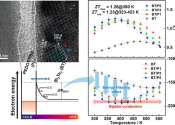Caltech researchers design a new nanomesh material
(PhysOrg.com) -- Computers, light bulbs, and even people generate heat—energy that ends up being wasted. With a thermoelectric device, which converts heat to electricity and vice versa, you can harness that otherwise wasted ...









